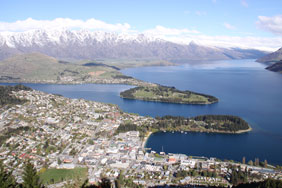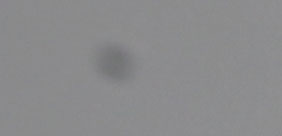Canon EOS 50D
-
-
Written by Gordon Laing
Canon EOS 50D lenses, focusing, sensor and drive
The Canon EOS 50D employs an EF lens mount and is fully compatible with both Canon EF and EF-S lenses. Thanks to its APS-C sensor size, all lenses effectively have their field of view reduced by 1.6 times.
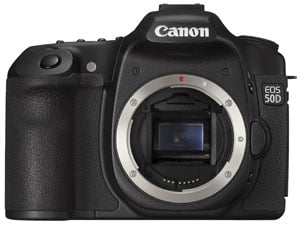 |
The EOS 50D is available as a body alone or in a kit with a stabilised zoom lens. Depending on your geographic region, there’ll be four main EOS 50D kits, bundled with either the EF-S 18-55mm IS, EF-S 17-85mm IS, the EF 28-135mm IS or the new EF-S 18-200mm IS. We tested the EOS 50D with the latter, a superzoom with an 11x optical range equivalent to 29-320mm, an f3.5-5.6 focal ratio, and Image Stabilisation to help counteract camera shake.
The design and build quality are roughly the same as the EF-S 55-250mm IS, with a large zoom ring closest to the lens mount and a thinner manual focusing ring towards the end of the lens. The manual ring turns when auto-focusing, but since your grip is further back on the zoom ring, it’s not a problem. The filter thread is 72mm and the end section of the lens does not rotate while focusing, which is good news for users of polarisers.
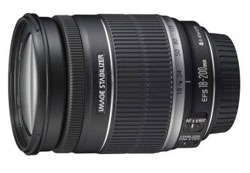 |
The lens doesn’t have USM or full-time manual focusing, but autofocus is reasonably quick on the EOS 50D, if quite audible. Like Nikkor’s DX 18-200mm VR, we noticed a little creep with the EF-S 18-200mm IS when it was pointed vertically up or down, although a small switch at the side will lock the barrel in its shortest position. Like all of Canon’s Non-L lenses, the lens hood continues to be an optional extra – please Canon, take notice of what your rivals are doing and don’t be so tight.
The EF-S 18-200mm IS will undoubtedly be a popular option for existing Canon DSLR owners, and to whet your appetite, you can see examples of its broad coverage below. To see samples of its image quality, check out our EOS 50D Results and Gallery pages. NEW: we’ve now fully tested the lens – see our Canon EF-S 18-200mm IS review.
|
Canon EOS 50D with EF-S 18-200mm IS coverage | ||
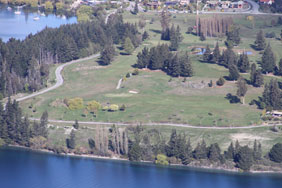 | ||
EF-S 18-200mm at 18mm (29mm equivalent) |
EF-S 18-200mm at 200mm (320mm equivalent) | |
Note: some owners of the EOS 50D have reported a higher than average occurrence of Error-99 communication issues between the body and lens. We tested our 50D with a variety of lenses and only experienced the Error-99 with a well-used press sample of the EF-S 17-85mm IS, and then only at certain focal lengths. When we switched to a newer private sample of this lens, we had no issues. As such we believe the problem we experienced was with the older sample of the EF-S 17-85mm IS, but we will report back if the problem returns with other lenses in the future. Update: Canon has released EOS 50D v1.0.3 firmware which is said to address the problem.
Canon EOS 50D focusing
The Canon EOS 50D employs the same 9-point AF system as the EOS 40D, although the AF algorithm has been improved. All nine points are cross-types, sensitive to both horizontal and vertical lines when used with lenses of f5.6 or brighter. The central point is also twice as sensitive as the others when used with a lens aperture of f2.8 or brighter.
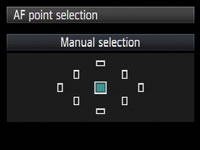 |
Like the 40D, the AF points are arranged in a diamond pattern and represented by small rectangular outlines which illuminate red when active; you can switch the red lights off if preferred in a custom menu.
Press the focus area button and you can use the joystick to manually select a single focus point or use the finger dial to cycle through the options. Under dim conditions, the flash will popup and flicker to provide AF assistance, but if you find this alarming, you can disable it or only request AF assistance from an external flashgun in a custom menu
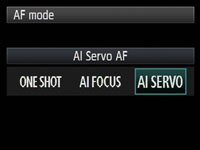 |
Like all Canon DSLRs there’s three auto-focusing modes: One Shot AF for still subjects, AI Servo AF for moving subjects, and AI Focus AF which automatically switches from One Shot to Servo when it detects a subject starting to move.
Fitted with the new EF-S 18-200mm IS lens, the EOS 50D focuses quickly and feels very responsive. The AF motor in the lens may be quite audible but mounted on this body it really can snap into focus quickly and without fuss. Zoomed-into 200mm, we found this lens and the 50D’s AI Servo AF mode was easily able to stay locked on vehicles approaching face-on at 50kph. Switch to a high-end lens with USM and the focusing speed improves a little, but the major difference is quieter operation (especially during the initial acquisition) and a manual focusing ring which allows full-time over-ride and doesn’t turn while auto-focusing.
So the EOS 50D may not feature the 51 AF points of the Nikon D300, nor even the 11 of the Nikon D90, but in use it certainly feels very quick and able to easily handle fast action. The D300 may have the edge when a subject changes distance unpredictably between focusing points, but if you can keep the action around the 50D’s diamond capture area, you’ll be fine in most situations.
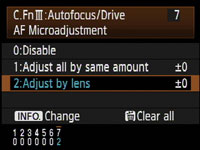 |
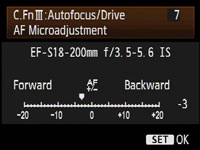 |
New to the EOS 50D over the 40D is support for AF Micro-adjustment. Inherited from the professional 1D series, this allows you to adjust the point of focus forward or back in +/- 20 very fine increments. You can apply adjustments globally to all lenses, or register individual settings for up to 20 different models of your choice.
When you attach that particular lens, the 50D recognises it and applies whatever settings you’ve stored. Should you try and register more than 20 lenses, the 50D will ask which ones you want to overwrite. We’re pleased to find this facility filter down to the 50D as it addresses a serious issue that affects many photographers, and will measure its effectiveness for a future article.
Canon EOS 50D metering, exposures and bracketing
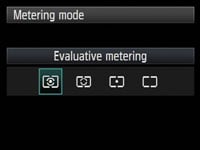 |
The Canon EOS 50D offers the same four metering modes as the 40D: 35-zone TTL Evaluative, Partial (9% of v/f area), Spot (3.8% of v/f area) and Center-weighted; the viewfinder also indicates the spot metering area with a circle. As before, we used Evaluative metering for all our sample images and found very few occasions when we’d want to apply any compensation.
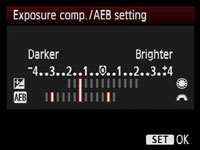 |
The EOS 50D offers shutter speeds from 1/8000 to 30 seconds plus a Bulb option; the fastest flash sync speed is 1/250 and the shutter block is rated for 100,000 cycles (same as the Nikon D90, but less than the 150,000 of the D300). Like the 40D before it, the 50D’s mirror and shutter employ a two-motor system for independent charging. This results in less vibration, quieter operation and a fairly unique motorised sound when you take a photo – check out our Canon EOS 50D video tour to hear it for yourself.
Exposure bracketing is available with three frames up to 2EV apart in 0.3EV increments, which puts it in line with the D90; the D300 however boasts up to nine frames which will appeal more to serious HDR enthusiasts. White balance bracketing is also available on the 50D, again with three frames, and at +/-3 levels in one level increments. If both exposure and white balance bracketing are active, the 50D will take nine frames.
Canon EOS 50D anti-dust
The EOS 50D offers the same three techniques as the EOS 40D to combat dust: anti-static coatings and materials to reduce it sticking in the first place, a vibrating filter which tries to shake-free the more stubborn particles, and a software-based solution which maps the position of any pesky marks and appends them to images for automatic removal later using the supplied Digital Photo Professional software. The EOS 50D’s sensor also now features a Fluorine coating which Canon claims offers greater resistance to dust
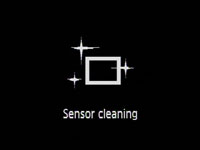 |
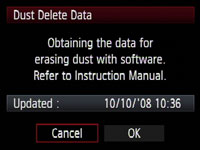 |
Following our usual DSLR torture-test we left our 50D face-up without a lens, inside and outside for ten minutes each; we can’t know how much dust entered the body during this time, nor even how much was present to start with, but we know such a process would result in dust being a problem for most models. We then updated the 50D’s Dust Delete Data and powered the camera on and off twice to vibrate the filter.
We then took a series of photos at every aperture setting of a plain white surface at close range with the EF-S 18-200mm IS lens zoomed-into 50mm and manually focused to infinity. Dust marks normally become most apparent at the smallest apertures (eg f16 and f22), but it’s also important to test at more common apertures.
|
Canon EOS 50D dust example at f22 / f8 | ||
 | ||
100% crop, 18-200mm at 50mm, f22 |
100% crop, 18-200mm at 50mm, f8 | |
With the 50D set to f22 we spotted just one dust mark on the image, pressed up against the left side; we’ve cropped it at 100% above left. Applying Auto Levels to the whole image revealed a number of fainter marks, but these weren’t visible under normal conditions.
As the aperture was opened, the visible mark became larger, more diffused and trickier to see. We’ve pictured the exact same area above right from the sample taken at f8 where the mark has grown to around three quarters of the crop height and become very faint.
The supplied Digital Photo Professional software identified that Dust Delete Data was present on both JPEG and RAW files, and used it to eliminate the offending mark with a single click from the Stamp Tool palette. So even though the 50D’s anti-dust system (like most DSLRs) wasn’t 100% infallible, we only found one mark after our torture-test and it was easily eliminated using the supplied software.
Canon EOS 50D sensor and processing
The Canon EOS 50D is equipped with a new 15.1 Megapixel CMOS sensor, measuring 22.3×14.9mm. It generates 3:2 aspect ratio images with a maximum resolution of 4752×3168 pixels, which gives it 864 more pixels horizontally and 576 pixels vertically than the EOS 40D; at 300 dpi, this allows the 50D’s images to be printed at 15.8×10.5in to the 40D’s 13×8.6in. The 12.2 Megapixel EOS 450D / XSi falls roughly in-between the two.
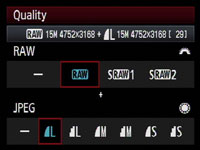 |
The 50D’s JPEGs can be recorded at two lower resolutions (8 and 3.7 Megapixels) and with the choice of Fine or Normal compression. RAW files are of course offered, although unusually again in the choice of three resolutions: either the full 15.1 Megapixels, 7.1 Megapixels in SRAW1 mode or 3.8 Megapixels in the new SRAW2 mode.
Cleverly the RAW and JPEG options can be set separately, allowing you to choose any combination. So if recording both JPEG and RAW, you could have RAW, SRAW1 or SRAW2, accompanied by a JPEG at any of the three resolutions or two compression settings. Best quality Large Fine JPEGS typically measure between 5 and 8MB each, while full-size RAW files measure 17 to 25MB each.
Like the 40D and 450D / XSi before it, the EOS 50D employs 14-bit analogue to digital conversions, and this 14-bit tonal detail is also recorded in the RAW images. See our Results pages for examples comparing the 50D’s JPEG and RAW output.
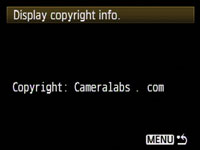 |
Copyright data can now be added to images, but unlike the Nikon D700 this can’t be edited in-camera; instead you’ll need to use the supplied EOS Utility.
The sensitivity runs between 100 and 3200 ISO, with the option of H1 and H2 settings offering an equivalent of 6400 and 12800 ISO respectively; note H1 and H2 will only be available if you enable ISO Expansion in the Custom settings. This gives the 50D the option of sensitivities two stops higher than the H1 (3200 ISO equivalent) setting on the 40D, although to see how they compare in terms of detail and noise levels, see our High ISO Results page. If Highlight Tone Protection is enabled, the 50D’s sensitivity range is reduced to 200-3200 ISO.
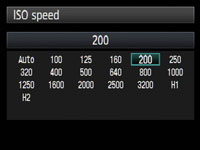 |
Like the 450D / XSi before it, the sensitivity sticks at 400 ISO when the ISO is set to Auto in Manual mode, so if you want lower sensitivities in Manual mode, ensure you also manually set the sensitivity; the 50D will at least tell you on its screens and in the viewfinder what ISO value it’s going to use when set to Auto though, so there shouldn’t be any nasty surprises.
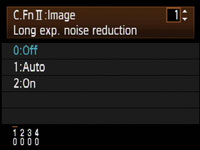 |
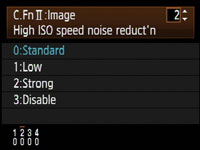 |
Like the EOS 40D, two noise reduction modes are available in the Custom Functions: Long Exposure Noise Reduction is applied to exposures longer than one second and can be set to Auto, On or Off, while High ISO Noise Reduction is applied throughout the range, but more so at higher sensitivities. High ISO Noise Reduction is now available with four settings: Standard (the default), Low, Strong or Disable, and we have examples of each in our High ISO Noise Reduction results page. Note Strong NR will reduce the maximum burst during continuous shooting.
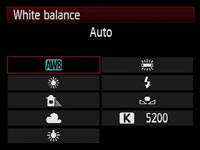 |
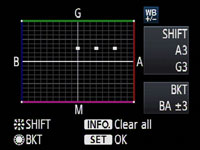 |
Pressing the White Balance button allows you to choose from Auto, Daylight, Shade, Cloudy, Tungsten, White Fluorescent, Flash and Custom, followed by the option to manually enter a colour temperature from 2500 to 10000 Kelvin. White Balance correction and bracketing is also available.
Sharpness, Contrast, Saturation and Colour Tone are applied using a number of Picture Styles: for colour photography, you have the choice of Standard, Portrait, Landscape, Neutral and Faithful, while a further Monochrome option offers four filter and four toning effects. Contrast, Saturation and Colour Tone can be adjusted in a new wider range of +/-4, while Sharpness is offered from 0 to 7. While it’s possible to tweak these presets or configure your own with the three custom modes in-camera, software supplied with EOS 50D lets you create and edit precision Picture Styles to your absolute requirements – just like the EOS 40D and 450D / XSi before it.
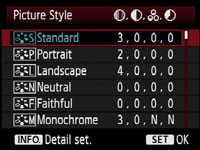 |
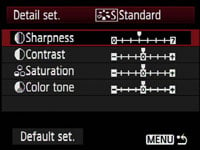 |
We used the default Standard Picture Style for all our sample images, and found it delivered a natural-looking balance which was neither overly punchy, nor too restrained. Like most of Canon’s recent DSLRs, the output is very smooth and can handle additional sharpening if you prefer a crisper results.
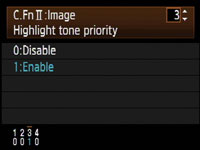 |
Leveraging the EOS 50D’s 14-bit A-D conversion is the Highlight Tone Priority (HTP) option, inherited from the EOS 40D and 450D / XSi and buried away in one of the custom function menus; it’s disabled by default. According to Canon, this improves the highlight detail by expanding the dynamic range from the standard 18% grey to bright highlights. This option is only available between 200 and 3200 ISO and Canon warns noise could be increased in shadow areas. New to the EOS 50D are ‘D+’ icons to indicate Highlight Tone Priority in the viewfinder and on both the upper and rear screens, so you should be in no doubt when it’s enabled.
To put this to the test we shot our standard outdoor resolution composition using the EOS 50D and EF-S 18-200mm IS with and without Highlight Tone Priority enabled. At this time of year, the peaks of the mountain range are covered in snow, which results in blown highlights when exposing for the main scene.
Below you can see crops taken from the upper left area with and without Highlight Tone Priority, and on decent quality monitors, it’s clear the version with the feature enabled has recorded highlight details which have become blown-out on the normal image. Checking the histograms reveals a slight compression to the tonal range which has then been shifted to the left to avoid saturation of the highlights. We didn’t notice any increase in noise in darker areas of this particular image, although it was taken under bright daylight. Highlight Tone Priority will undoubtedly be a popular option for wedding photographers along with anyone shooting in bright wintery conditions, but we wouldn’t recommend it for all situations. As always, check the result with examples of your own to see if its having a benefit.
|
Canon EOS 50D JPEG Highlight Tone Priority Disabled (default) |
Canon EOS 50D JPEG Highlight Tone Priority Enabled | |
 | ||
1/500, f8, 200 ISO |
1/500, f8, 200 ISO |
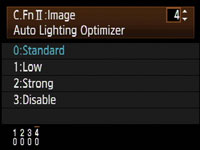 |
The EOS 50D additionally inherits the Auto Lighting Optimizer from the 40D and 450D / XSi, which adjusts the brightness and contrast of images with dark areas (such as backlit portraits), although the implementation is slightly different on all three models.
The EOS 40D offered only one Auto Lighting Optimizer mode and it was always applied in Auto or the Scene Presets, but wasn’t available in PASM or A-DEP modes. On the 450D / XSi, there was again only one Auto Lighting Optimizer mode and again it was always applied in Auto or the Scene Presets. But the 450D / XSi also let you apply it in PASM or A-DEP modes, and enabled it by default; you could disable it in a custom menu if preferred.
On the 50D, there’s now four different Auto Lighting Optimizer settings: Standard, Low, Strong and Disable. The Standard setting is always applied when the 50D is set to Auto or the Scene presets, and is also applied by default in PASM or A-DEP modes, although you can adjust it in the custom menu to one of the other three settings. Canon describes the Low setting to be weaker than the On setting of the 450D / XSi, although both the Standard and Strong settings are stronger.
Canon EOS 50D Auto Lighting Optimiser: Off / Strong | ||
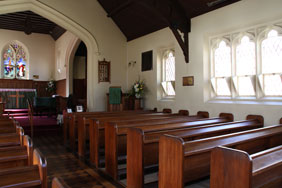 |
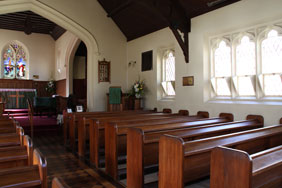 | |
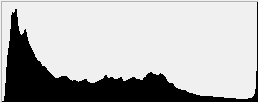 | 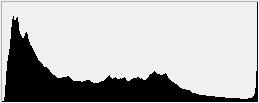 | |
Auto Lighting Optimiser Off: 100 ISO, f8, 0.5 sec |
Auto Lighting Optimiser Strong: 100 ISO, f8, 0.5 sec | |
Above you can see two examples of the same composition taken with the Auto Lighting Optimizer disabled (above left) and with its Strong setting (above right). In this particular example which includes dark shadow areas and blown highlights, we can see very little evidence of the Auto Lighting Optimiser in action. The shadows remain dark and the bright window highlights remain saturated. Lest you think it’s the same image, we’ve included histograms of each which reveal a very slight reduction in the shadow peak on the version with Strong Auto Lighting Optimization, but little difference overall.
Following our policy of using default settings when testing cameras, most of the same images you’ll see in this review were taken with Highlight Tone Priority off and the Active Lighting Optimizer set to Standard. Since both can result in artificially higher noise levels though, we ensured both were disabled for our High ISO Results page.
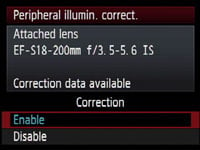 |
New to the EOS 50D is Peripheral Illumination Correction. This is optionally applied to JPEG images to reduce the effect of vignetting where the image darkens towards the corners; this is the first time such correction has been built-into a Canon DSLR. The EOS 50D contains a database of 26 Canon lenses and allows you to enter a further 14 models. If the lens model is recognised, the correction will be applied by default to JPEG images, although you can switch the option off if preferred. Canon describes the resulting effect as similar to that offered on RAW images in recent versions of its Digital Photo Professional (DPP) software, although DPP itself can offer additional corrections.
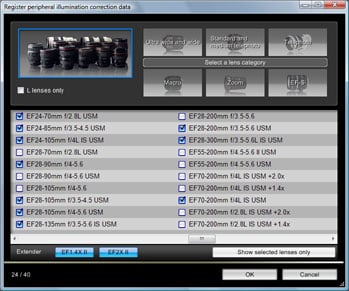 |
Any lens for which DPP offers corrections can be entered into the 50D’s internal database using the supplied EOS Utility – see left. At the time of writing, the latest version of DPP offered correction data from a choice of 82 Canon lenses including all EF-S models and the latest EF-S 18-200mm IS super-zoom. DPP also offers data for each lens fitted with a 1.4x or 2x Extender, although these will count as additional entries in the 50D’s 40-model database.
Since Peripheral Illumination Correction is enabled by default, you’ll see the effect of it on our JPEG sample images throughout this review taken with the EF-S 18-200mm IS. To test its effectiveness in practice though, we have examples below taken with the EF-S 17-85mm IS when zoomed-out to 17mm and with its aperture open to f4, at which point this lens normally suffers from quite noticeable vignetting. As a popular EF-S zoom, this lens was already loaded in the 50D’s internal database. The tests were taken of an evenly-lit white surface using a diffused filter and the lens focused to infinity.
|
Canon EOS 50D with EF-S 17-85mm IS Peripheral Illumination Correction: On (default) / Off | ||
 |  | |
EF-S 17-85mm at 17mm f4 Peripheral Illumination Correction Enabled |
EF-S 17-85mm at 17mm f4 Peripheral Illumination Correction Disabled | |
As you can clearly see above, the 50D’s in-camera Peripheral Illumination Correction has greatly reduced the effect of vignetting on our sample, although there’s still some darkening in the extreme corners. It remains a big improvement over the version without though, but remember any digital brightening will result in potentially greater visible noise in the applied areas.
Canon EOS 50D drive modes and remote control
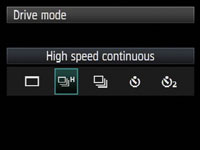 |
 |
The Canon EOS 50D offers two continuous shooting modes: Low which shoots at 3fps and High which shoots at 6.3fps. The latter is a fraction below the 6.5fps rating of the 40D, but considering there’s 50% more data being shifted, we’re not complaining.
The EOS 50D now supports quick UDMA Compact Flash cards which allow it to capture impressive bursts of either 90 JPEGs (compared to 75 on the 40D) or 16 RAW frames (same on the 40D). Support for even faster Class 6 UDMA cards in the future should see these figures increase.
To put these figures to the test we fitted the EOS 50D with a formatted Lexar Professional UDMA 4GB 300x Compact Flash card and set the camera to Continuous High. In Large Fine JPEG mode, the 50D rattled-off no fewer than 125 JPEGs in 20.5 seconds before slowing slightly, corresponding to a rate of 6.1fps. Set to RAW mode, the 50D managed the quoted 16 RAW frames before slowing, in 2.7 seconds, corresponding to a rate of 5.9fps. Writing to the card was very fast, with the process completed after only a few seconds.
In both cases, the 50D’s continuous shooting rate was measured at slightly less than the quoted 6.3fps, and coincidentally virtually matched the rates we previously measured for the 40D in practice, despite that model’s higher claims of 6.5fps. Either way though, achieving around 6fps in practice is still very impressive and allows the 50D, like the 40D before it, to grab plenty of frames during fast action sequences. It’s even more impressive when you consider the much greater amount of data being processed – clearly DIGIC 4 can race through its calculations and support for UDMA cards allows the data to be cleared from the buffer very quickly.
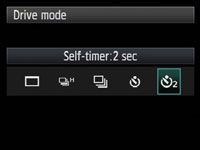 |
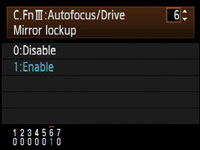 |
In terms of the self-timer, the EOS 50D gives you the choice of 10 or 2 second countdowns, although it doesn’t share the additional custom timer of the 450D / XSi which can take multiple shots as insurance. A mirror lockup option is however available in the custom menu, which applies to either normal or self-timed shots. Unlike the Nikon D300, there’s no built-in Intervalometer, but in its favour, the 50D can achieve this and more when connected to a computer with supplied software.
In a feature which first made its debut on the EOS 40D, the 50D can be connected to a PC or Mac with a USB cable and remote controlled using the supplied EOS Utility. Images can be recorded to your computer’s hard disk, the internal memory card or both, and there’s Intervalometer facilities for programmed shoots.
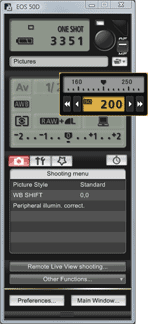 |
The EOS Utility lets you remote control and adjust pretty much any setting that doesn’t involve a physical dial or switch. So you can’t change the exposure mode from, say, Aperture to Shutter Priority using the software, but you can adjust the aperture or shutter value, the quality, white balance, metering or sensitivity for example. Impressively the software also lets you see the Live View on your computer monitor and even lets you manually focus the lens with a magnified view for assistance. We have a demonstration of this in our EOS 50D video tour.
New to version 2.5 which comes supplied with the EOS 50D is the option to switch the camera between autofocus and manual focus. If the former is selected, the camera will autofocus if you pass the mouse over the graphical shutter release ‘button’ on-screen; it’s acting as a virtual half-press. You’ll also see a Peripheral Illumination Correction section which lets you choose which 40 lenses from the entire Canon EF catalogue should populate the 50D’s internal database.
Software-based remote control is a wonderful feature to have and if you have a laptop handy, it could even eliminate the need for certain photographers to invest in a cable release. In fact the only downside we could find was the inability for the USB port to power the camera itself, thereby making an AC adapter mandatory for serious unattended time-lapse photography. If you have the optional WFT-E3(A) wireless transmitter connected, you can also dispense with the short USB cable and either use a considerably longer CAT-5 Ethernet cable or exploit the wireless freedom of a Wifi connection – see our Canon WFT-E3(A) review for more details and a video demonstration.
Note: remote control with the EOS Utility is also supported on the EOS 40D, EOS 450D / XSi and even the entry-level EOS 1000D / XS. So while Canon can be tight about not supplying lens hoods with its non-L models, it certainly doesn’t skimp on the bundled software. Similar remote control software – often without the Live View capabilities – is an optional extra from other manufacturers, and Canon also bundles decent RAW processing software with its Digital Photo Professional.
